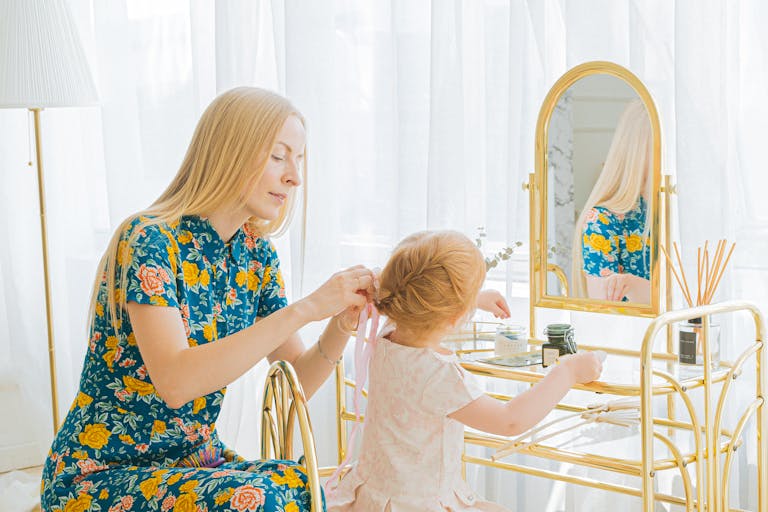How to Create a Reading Nook at Home: A Mother’s Guide to Cultivating Readers
I found my daughter curled up in her closet last week, surrounded by a pillow fortress and her fuzzy blanket, halfway through Anne of Green Gables.
“Why are you reading in the closet?” I asked, genuinely puzzled.
She looked up at me like the answer was obvious. “It’s cozy in here.”
And honestly? She had a point.
Children instinctively understand something that we adults often overlook: where we read matters. The right environment transforms reading from an assignment into an escape, from something we should do into something we want to do.
In a world where screens compete relentlessly for our daughters’ attention, creating a dedicated reading space is one of the most powerful things we can do to tip the scales toward books. Not because we’re forcing the issue, but because we’re making reading irresistible.
This isn’t about Pinterest perfection or expensive furniture. It’s about carving out a corner of your home that whispers, “Come. Sit. Stay awhile.” A space so inviting that your daughter chooses it over the iPad without being asked.
Here’s how to make that happen.

Why a Dedicated Reading Space Changes Everything
Before we talk about throw pillows and lighting (and we will), let’s discuss why this matters so much.
It signals priority. We dedicate space to what we value. A playroom says play matters. A craft area says creativity matters. A reading nook says books matter, learning matters, quiet reflection matters. Your daughter absorbs this message without you ever saying a word.
It removes friction. When everything needed for reading is in one comfortable spot, there’s nothing standing between your daughter and a good book. No hunting for a comfortable seat, no searching for proper light, no wondering where she left her current read. She can simply sink in and begin.
It creates positive associations. Over time, that cozy corner becomes linked in her mind with the pleasure of stories, the satisfaction of finishing a chapter, the comfort of familiar characters. The space itself becomes a trigger for the reading habit.
It provides refuge. Every child needs a place to retreat, to think, to be alone with her thoughts. A reading nook serves this purpose beautifully. It’s a socially acceptable way for her to step away from the noise without isolating herself entirely.
Research consistently shows that children who have access to books and a comfortable place to read them are more likely to read for pleasure. And children who read for pleasure become adults who read for growth, for information, for wisdom. We’re not just creating a cozy corner. We’re cultivating a lifelong learner.

Choosing the Right Location
The best reading nook is one your daughter will actually use. This sounds obvious, but it’s worth examining carefully before you commit to a spot.
Consider traffic patterns. A reading nook tucked behind the main flow of family activity allows for concentration without complete isolation. She can hear the comforting sounds of home while still feeling she has her own space. Avoid high-traffic areas where siblings will constantly interrupt, but don’t banish the nook to a forgotten corner she’ll never visit.
Think about supervision needs. For younger children, a reading nook visible from common areas allows you to keep an eye on things while still giving her a sense of independence. As daughters get older, more private locations become appropriate.
Evaluate existing spaces. You don’t necessarily need to create something from scratch. Look for underutilized areas that could be transformed:
A wide window seat already invites lingering. Add a cushion and you’re nearly done.
The space under a loft bed creates a natural sense of enclosure that children love.
An unused corner of her bedroom can be sectioned off with a simple curtain or bookshelf.
A closet with the door removed (or kept open) becomes a surprisingly cozy cave.
A covered porch or verandah extends reading possibilities into fair weather, complete with natural light and fresh air.
An awkward alcove or the space under stairs transforms from wasted square footage into a cherished retreat.
Account for natural light. Reading by natural light is easier on the eyes and more pleasant overall. If possible, position the nook near a window. That said, don’t let the absence of a window stop you. Proper artificial lighting (which we’ll discuss) makes any location workable.

The Essential Elements
Every good reading nook needs four things: comfortable seating, proper lighting, accessible books, and personal touches. Everything else is optional. Let’s break these down.
Comfortable Seating: The Heart of the Nook
The seat is everything. If it’s not genuinely comfortable, she won’t stay long.
The best option is whatever invites lingering. This varies by child. Some prefer to curl up in a plush armchair. Others like sprawling on floor cushions. Still others want a swing or hammock that moves gently while they read. Pay attention to where your daughter naturally gravitates when she’s relaxing, and let that inform your choice.
Quality matters more than expense. A well-made armchair from a thrift store, properly cleaned and perhaps recovered, will serve better than a cheap new piece that flattens within months. Look for sturdy construction and cushions that maintain their shape.
Size appropriately. For young children, an oversized chair feels like a throne, which delights them. For tweens and teens, something more proportionate to their growing frames makes sense. Consider whether she’ll want to tuck her legs up, stretch them out, or curl on her side, and choose accordingly.
Add layers. Even the best chair benefits from soft additions. A throw blanket serves multiple purposes: warmth, comfort, and that crucial sense of being wrapped in coziness. A throw pillow or two provides support for various reading positions.
Invest in quality textiles here. Soft cashmere, chunky knit, or quality wool feels luxurious against the skin and signals that this space is special. These pieces become part of the ritual. She wraps herself in that particular blanket, tucks that particular pillow behind her head, and her brain knows: reading time.
Don’t overlook the floor. Some children genuinely prefer reading on the floor. If yours does, honor that preference with a plush rug, oversized floor cushions, or even a thick mattress pad covered with soft fabric. A canopy overhead can add the sense of enclosure that makes floor-based nooks feel special rather than makeshift.
Lighting: The Unsung Hero
Poor lighting kills a reading habit faster than almost anything else. Eye strain leads to headaches, which leads to avoiding books entirely. Proper lighting is non-negotiable.
Natural light is ideal but not always available. Position reading time during daylight hours when possible, especially for younger children. But since reading often happens in the evening or in interior spaces, artificial lighting must be carefully considered.
The goal is focused, warm light. You want illumination directed onto the page without harsh glare. Overhead room lighting rarely accomplishes this. Instead, plan for task lighting specifically designed for reading.
A floor lamp with an adjustable arm allows light to be positioned exactly where needed. Look for classic styles that feel intentional rather than purely functional.
A quality table lamp on a small side table serves double duty, providing both light and a surface for her current book and a cup of tea.
Clip-on book lights work well for enclosed spaces like closet nooks or canopy beds where larger lamps won’t fit.
Avoid harsh LED lighting. The blue light emitted by many LED bulbs can strain eyes and disrupt sleep patterns if reading happens near bedtime. Choose warm-toned bulbs (look for “soft white” or bulbs rated 2700K or lower) that mimic the gentler glow of incandescent lighting.
For outdoor nooks, plan for evening use. Battery-operated lamps in classic styles, lanterns, or even pillar candles in hurricane glass extend porch reading into twilight. There’s something magical about reading by candlelight that screens simply cannot replicate.
Accessible Books: Within Arm’s Reach
A reading nook without nearby books is just a chair. Make it easy for her to reach for the next adventure.
Create a “currently reading” station. A small side table, a basket, or a single shelf within arm’s reach should hold whatever books are in rotation. This eliminates the need to get up and search, which is exactly the kind of friction that interrupts a reading session.
Curate a small collection nearby. Beyond her current read, keep a rotating selection of books in or near the nook. This might be a neat stack in a carefully placed vintage magazine rack, a few titles displayed on a ledge, or a small bookshelf serving as both storage and room divider. The idea is that when she finishes one book, the next adventure is right there waiting.
Make it visually appealing. Books displayed cover-out are more inviting than spines-out. Even mixing in a few cover-facing titles among spine-facing ones adds visual interest and makes selection easier for younger children who don’t yet read titles fluently.
Maintain a “to be read” stack. After library visits or book purchases, add new titles to a dedicated spot. This ready queue means she’s never stuck wondering what to read next. Some families call this the “book buffet” because it offers choices without overwhelm.
Personal Touches: Making It Hers
The difference between a reading corner and her reading corner lies in personalization. This space should reflect her personality and feel like it belongs to her.
Let her participate in creating it. Even young children can choose the color of a throw pillow or pick which stuffed animal will keep them company during reading time. Older daughters can have more input on furniture choices, color schemes, and decorative elements. The more ownership she feels, the more she’ll use the space.
Include meaningful items. Perhaps a small framed quote about books or learning. A piece of art she chose herself. A photo of a beloved grandmother who instilled her love of stories. A small plant she cares for. These details transform a generic corner into a personal sanctuary.
Consider a journaling station. A small surface to hold a notebook and pen encourages her to record thoughts about what she’s reading. This might be as simple as a pretty journal and a cup of pencils on the side table. For older daughters in families interested in the Charlotte Mason tradition, introduce the concept of a commonplace book: a personal treasury where she copies passages, poems, and ideas that resonate with her. This practice transforms passive reading into active engagement.
Add gentle sensory elements. A small dish of her favorite mints. A scented candle (for older children, supervised or unlit for scent alone). A soft textured throw. These small pleasures make the space multi-sensory and even more inviting.

Creating the Atmosphere
Beyond the physical elements, atmosphere matters. The reading nook should feel distinct from the rest of the house in mood and intention.
Minimize visual clutter. A serene space invites concentration. Keep the nook tidy and purposeful. This doesn’t mean sterile, but it does mean avoiding the pile-up of random items that tends to accumulate in any corner of a family home. Regular tidying maintains the space’s peaceful quality.
Consider partial enclosure. Children love the feeling of being tucked away. A canopy overhead, curtains that can be drawn, or even positioning the nook in a corner with bookshelves creating “walls” on two sides gives the sense of a secret space without actually isolating her.
Protect the space from intrusion. If younger siblings are tempted to disrupt reading time, establish clear family expectations. The reading nook, when occupied, is a quiet zone. This boundary teaches respect for others’ need for solitude while protecting your daughter’s reading time from constant interruption.
Set the tone with your own habits. Children notice what we do far more than what we say. If you have your own reading spot, if they see you choosing books over screens in your leisure time, if the family culture treats reading as normal and desirable, the nook becomes part of a larger context rather than a strange exception.

Beyond Reading: Extended Uses
A well-designed reading nook serves multiple purposes, all of which support the kind of thoughtful, creative child we hope to raise.
Quiet creative work. Drawing, hand lettering, watercolor painting, needlework. These quiet, focused activities pair beautifully with a cozy nook. Consider keeping a small basket of art supplies nearby (kept neat and organized) to extend the possibilities.
Reflection and journaling. The same space that invites reading invites writing. Tweens and teens especially may appreciate having a private spot to process their thoughts on paper.
Audio learning. Audiobooks, educational podcasts, music appreciation. All of these work wonderfully in a comfortable spot designed for focused attention.
Simple rest. Sometimes a child needs a place to simply be still. The nook provides this without requiring a reason or excuse.
Age-Specific Considerations
The ideal reading nook evolves as your daughter grows.
For toddlers and preschoolers (ages 2-5): Focus on safety first. Nothing tip-able, no small decorative items that could be choking hazards, nothing precious that will be destroyed by sticky fingers. Keep it simple: a large floor cushion, a basket of board books, and a few soft stuffed animals. At this age, you’ll likely be reading together, so ensure the space accommodates both of you.
For early readers (ages 6-9): Independence increases, but she still wants you nearby. A nook visible from common areas works well. Add a small lamp she can operate herself, a basket for her current library haul, and perhaps a special blanket. Let her choose some decorative elements.
For tweens (ages 10-12): Privacy becomes more important. A nook in her bedroom or a more secluded corner allows her to retreat. Include a journal and nice pen for recording thoughts. She may want to decorate the space herself. Offer guidance, but give her ownership.
For teens (ages 13+): Respect her aesthetic preferences even if they differ from yours. A teen reading nook might look quite different from what you’d choose, and that’s fine. What matters is that she uses it. Consider adding a small electric kettle for tea and a nice mug to make the experience feel grown-up and self-sufficient.

Making It Happen: Practical Steps
Ready to create a reading nook? Here’s a simple action plan:
This week: Observe and plan. Watch where your daughter naturally curls up to read or rest. Notice what spots she gravitates toward. Consider which underutilized areas of your home could be transformed. Discuss the idea with her and gauge her enthusiasm.
Next week: Establish the foundation. Clear the chosen space. Add the essential seating element, whether that’s moving a chair, adding floor cushions, or installing a window seat cushion. Position a lamp for good lighting. Bring in a small collection of books.
The following week: Add comfort and personalization. Layer in the blanket and pillows. Add the side table or basket for books. Let your daughter contribute personal touches. Stock the space with her current reads.
Ongoing: Maintain and evolve. Keep the space tidy and inviting. Rotate books regularly. Adjust elements as needed based on how she actually uses the space. Make it a living part of your home rather than a static display.

The Real Goal
I’ll end where we began: with my daughter in her closet, cup of hot tea in hand.
That moment told me she already understood what I was hoping to teach her. She had found her own reading sanctuary, cobbled together from what was available, because the pull of a good book was strong enough to make her seek out coziness on her own terms.
Our job as mothers isn’t to create magazine-perfect spaces. It’s to remove obstacles between our daughters and books, to demonstrate by our own habits that reading matters, and to provide environments where falling into a story feels natural and good.
The reading nook you create doesn’t need to be elaborate. It needs to be inviting. It needs to be hers. And it needs to hold books worth reading.
Proverbs 24:3-4 tells us, “By wisdom a house is built, and through understanding it is established; through knowledge its rooms are filled with rare and beautiful treasures.” A reading nook filled with good books is one of those rare and beautiful treasures, quietly building wisdom in the next generation, one story at a time.
Start small. Start today. And watch what grows.
What does your daughter’s reading spot look like? Share your creative solutions in the comments!
Related Posts:
Building Your Daughter’s First Library: Books Worth Owning
Hair Bow Storage Ideas: Creating an Organized Station
Screen-Free Activities for Thoughtful Girls







